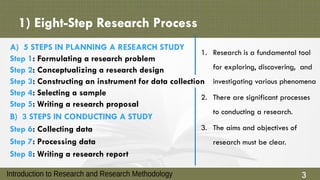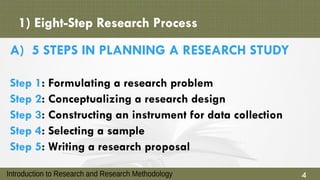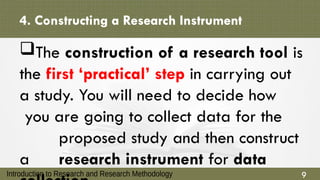LECTURE II. Introduction to Research Methodology (Steps in Conducting Research) (AIU), 20 Sept 2023.pptx
- 1. Afghan International University PhD Program of Study in Structure LECTURE II: STEPS IN CONDUCTING RESEARCH Prof. Dr. Abdul Qayeum Karim Email: aqkarim19@gmail.com, Phone: +93 700 591991 Sept. 2023
- 2. Table of Contents 1. Eight Steps in Conducting Research 2. Five Steps in Planning a Research 3. Three Steps in Conducting a Research 4. Conclusion
- 3. 1) Eight-Step Research Process 3 A) 5 STEPS IN PLANNING A RESEARCH STUDY Step 1: Formulating a research problem Step 2: Conceptualizing a research design Step 3: Constructing an instrument for data collection Step 4: Selecting a sample Step 5: Writing a research proposal B) 3 STEPS IN CONDUCTING A STUDY Step 6: Collecting data Step 7: Processing data Step 8: Writing a research report 1. Research is a fundamental tool for exploring, discovering, and investigating various phenomena 2. There are significant processes to conducting a research. 3. The aims and objectives of research must be clear.
- 4. 1) Eight-Step Research Process 4 A) 5 STEPS IN PLANNING A RESEARCH STUDY Step 1: Formulating a research problem Step 2: Conceptualizing a research design Step 3: Constructing an instrument for data collection Step 4: Selecting a sample Step 5: Writing a research proposal
- 5. 1) Eight-Step Research Process 5 B) 3 STEPS IN CONDUCTING A STUDY Step 6: Collecting data Step 7: Processing data Step 8: Writing a research report
- 6. 2) Formulating a Research Problem 6 Formulating a Research Problem A research problem identifies your destination: It should tell WHAT you intend to research. The more specific and clear you are, the better you formulate your research problem.
- 7. 3. Conceptualizing a Research Design 7 2. Conceptualizing a Research Design The main function of a research design is to explain how you will find answers to your research questions. The research design sets out the logic of your inquiry. A research design should include: ŌĆó the study design, ’é¦ the measurement procedures, ’é¦ the sampling strategy, ’é¦ the frame of analysis, and ’é¦ the time-frame.
- 8. 4. Constructing a Research Instrument 8 ’ü▒ Research tool: It is a mean of collecting information. For example, observation forms, interview schedule, questionnaires, and interview guides are all classified as research tools.
- 9. 4. Constructing a Research Instrument 9 ’ü▒The construction of a research tool is the first ŌĆśpracticalŌĆÖ step in carrying out a study. You will need to decide how you are going to collect data for the proposed study and then construct a research instrument for data
- 10. 4. Constructing a Research Instrument 10 ’ü▒If you are planning to collect data specifically for your study (primary data), you need to either construct a research instrument or select an already constructed one.
- 11. 5. Selecting a Sample 11 ’ü▒The accuracy of your estimates largely depends up on the way you select your sample. ’ü▒The basic objective of any sampling design is to minimize, within the limitation of cost, the gap between the values obtained from your sample and those prevalent in the population.
- 12. 6. Collecting Data 12 By Now, DONE: - Formulated a research problem, - study design, - research instruments - selected samples, Now: Collect the data to be used in drawing Conclusion. As a part of the research design, decided upon the procedure to collect your data. At this stage: You actually collect the data. For example, depending upon your plans, you might: - Commence interviews, - mail out a questionnaire, - conduct nominal/focused group discussion, or - make observations. - Conducting Experiments
- 13. 6. Collecting Data 13 Collected Data Analysis depends on: 1- the type of information ŌĆō descriptive, quantitative, qualitative or attitudinal, and 2- the way you want to write your dissertation/report/paper There are quantitative and qualitative reports. In most studies one needs to combine quantitative and qualitative skills.
- 14. 8. Writing a Research Report 14 ’ü▒Writing the report is the last and, for many, the most difficult step of the research process. ’ü▒It informs the world of: - what you have done, - what have you discovered, and - what conclusions you have drawn from your findings. If you are clear about the whole process, you will also be clear about the way you want to write your report.
- 15. Conclusion 15 The research process is a systematic and organized approach that helps researchers: -gather information, -analyze data, and -draw conclusions. The success of any research project largely depends on: - the thoroughness, and - accuracy of each step in the process.
- 16. Conclusion (Cont. . . . .) 16 Research involves some important stages including: - defining the research problem, - developing a research design, - collecting data, - analyzing data, and - writing a report.
- 17. THANK YOU INTRODUCTION TO RESEARCH AND RESEARCH METHODOLOGY
















